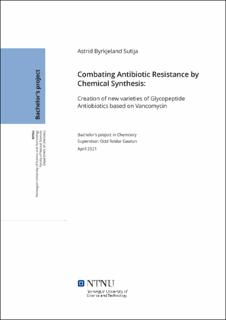Sammendrag
The emergence of multi-resistant bacteria has been described by WHO as the gravest disease threat we face, claiming up to 700,000 lives annually. Antibiotics of last-resort, such as the glycopeptide class antibiotic Vancomycin, play an integral role in the suppression of gram-positive pathogens, such as methicillin-resistant Staphylococcus aureus (MRSA). The emergence of both Entercocci and Aureus bacteria resistant to Vancomycin has recently been confirmed, leading to efforts to modify Vancomycin by chemical synthesis to maintain its efficacy. This review will describe the methods used to achieve an active 3 > 2 > 1 mechanism against resistant bacteria. This includes ligand substitution, as a single heavy atom exchange, as well as two peripheral modifications. The three mechanism are independent of each other, thus providing the antibiotic with a attack in three stages. Such modifications have been found to be not only effective, but are likely to remain so, as simple chemical substitution in the gram-positive bacteria’s cell wall is unlikely to effectively block the pathways used by this modified class of Vancomycin-related antibiotics.
